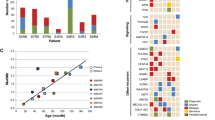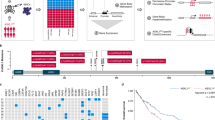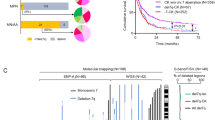Abstract
Acute leukemia characterized by chromosomal rearrangements requires additional molecular disruptions to develop into full-blown malignancy1,2, yet the cooperative mechanisms remain elusive. Using whole-genome sequencing of a pair of monozygotic twins discordant for MLL (also called KMT2A) gene–rearranged leukemia, we identified a transforming MLL-NRIP3 fusion gene3 and biallelic mutations in SETD2 (encoding a histone H3K36 methyltransferase)4. Moreover, loss-of-function point mutations in SETD2 were recurrent (6.2%) in 241 patients with acute leukemia and were associated with multiple major chromosomal aberrations. We observed a global loss of H3K36 trimethylation (H3K36me3) in leukemic blasts with mutations in SETD2. In the presence of a genetic lesion, downregulation of SETD2 contributed to both initiation and progression during leukemia development by promoting the self-renewal potential of leukemia stem cells. Therefore, our study provides compelling evidence for SETD2 as a new tumor suppressor. Disruption of the SETD2-H3K36me3 pathway is a distinct epigenetic mechanism for leukemia development.
This is a preview of subscription content, access via your institution
Access options
Subscribe to this journal
Receive 12 print issues and online access
$209.00 per year
only $17.42 per issue
Buy this article
- Purchase on Springer Link
- Instant access to full article PDF
Prices may be subject to local taxes which are calculated during checkout





Similar content being viewed by others
Accession codes
Primary accessions
Sequence Read Archive
Referenced accessions
NCBI Reference Sequence
References
Krivtsov, A.V. & Armstrong, S.A. MLL translocations, histone modifications and leukaemia stem-cell development. Nat. Rev. Cancer 7, 823–833 (2007).
Cancer Genome Atlas Research Network. Genomic and epigenomic landscapes of adult de novo acute myeloid leukemia. N. Engl. J. Med. 368, 2059–2074 (2013).
Balgobind, B.V. et al. NRIP3: a novel translocation partner of MLL detected in a pediatric acute myeloid leukemia with complex chromosome 11 rearrangements. Haematologica 94, 1033 (2009).
Sun, X.J. et al. Identification and characterization of a novel human histone H3 lysine 36–specific methyltransferase. J. Biol. Chem. 280, 35261–35271 (2005).
Zhang, Y. & Rowley, J.D. Chromatin structural elements and chromosomal translocations in leukemia. DNA Repair (Amst.) 5, 1282–1297 (2006).
Zhang, Y. et al. The role of mechanistic factors in promoting chromosomal translocations found in lymphoid and other cancers. Adv. Immunol. 106, 93–133 (2010).
Mitelman, F., Johansson, B. & Mertens, F. The impact of translocations and gene fusions on cancer causation. Nat. Rev. Cancer 7, 233–245 (2007).
Balgobind, B.V., Zwaan, C.M., Pieters, R. & Van den Heuvel-Eibrink, M.M. The heterogeneity of pediatric MLL-rearranged acute myeloid leukemia. Leukemia 25, 1239–1248 (2011).
Greaves, M.F. & Wiemels, J. Origins of chromosome translocations in childhood leukaemia. Nat. Rev. Cancer 3, 639–649 (2003).
Edmunds, J.W., Mahadevan, L.C. & Clayton, A.L. Dynamic histone H3 methylation during gene induction: HYPB/Setd2 mediates all H3K36 trimethylation. EMBO J. 27, 406–420 (2008).
Berger, S.L. The complex language of chromatin regulation during transcription. Nature 447, 407–412 (2007).
Liu, H., Xing, Y., Yang, S. & Tian, D. Remarkable difference of somatic mutation patterns between oncogenes and tumor suppressor genes. Oncol. Rep. 26, 1539–1546 (2011).
Mayshar, Y. et al. Identification and classification of chromosomal aberrations in human induced pluripotent stem cells. Cell Stem Cell 7, 521–531 (2010).
Ben-David, U., Mayshar, Y. & Benvenisty, N. Large-scale analysis reveals acquisition of lineage-specific chromosomal aberrations in human adult stem cells. Cell Stem Cell 9, 97–102 (2011).
Dondeti, V.R. et al. Integrative genomic analyses of sporadic clear cell renal cell carcinoma define disease subtypes and potential new therapeutic targets. Cancer Res. 72, 112–121 (2012).
Cancer Genome Atlas Research Network. Comprehensive molecular characterization of clear cell renal cell carcinoma. Nature 499, 43–49 (2013).
Rhodes, D.R. et al. Oncomine 3.0: genes, pathways, and networks in a collection of 18,000 cancer gene expression profiles. Neoplasia 9, 166–180 (2007).
Li, M. et al. Solution structure of the Set2-Rpb1 interacting domain of human Set2 and its interaction with the hyperphosphorylated C-terminal domain of Rpb1. Proc. Natl. Acad. Sci. USA 102, 17636–17641 (2005).
Duns, G. et al. Histone methyltransferase gene SETD2 is a novel tumor suppressor gene in clear cell renal cell carcinoma. Cancer Res. 70, 4287–4291 (2010).
Fontebasso, A.M. et al. Mutations in SETD2 and genes affecting histone H3K36 methylation target hemispheric high-grade gliomas. Acta Neuropathol. 125, 659–669 (2013).
Cleary, M.L. Regulating the leukaemia stem cell. Best Pract. Res. Clin. Haematol. 22, 483–487 (2009).
Corral, J. et al. An Mll-AF9 fusion gene made by homologous recombination causes acute leukemia in chimeric mice: a method to create fusion oncogenes. Cell 85, 853–861 (1996).
Dorrance, A.M. et al. Mll partial tandem duplication induces aberrant Hox expression in vivo via specific epigenetic alterations. J. Clin. Invest. 116, 2707–2716 (2006).
Higuchi, M. et al. Expression of a conditional AML1-ETO oncogene bypasses embryonic lethality and establishes a murine model of human t(8;21) acute myeloid leukemia. Cancer Cell 1, 63–74 (2002).
Zorko, N.A. et al. Mll partial tandem duplication and Flt3 internal tandem duplication in a double knock-in mouse recapitulates features of counterpart human acute myeloid leukemias. Blood 120, 1130–1136 (2012).
Grisolano, J.L., O'Neal, J., Cain, J. & Tomasson, M.H. An activated receptor tyrosine kinase, TEL/PDGFβR, cooperates with AML1/ETO to induce acute myeloid leukemia in mice. Proc. Natl. Acad. Sci. USA 100, 9506–9511 (2003).
Subramanian, A. et al. Gene set enrichment analysis: a knowledge-based approach for interpreting genome-wide expression profiles. Proc. Natl. Acad. Sci. USA 102, 15545–15550 (2005).
Gal, H. et al. Gene expression profiles of AML derived stem cells; similarity to hematopoietic stem cells. Leukemia 20, 2147–2154 (2006).
Wong, D.J. et al. Module map of stem cell genes guides creation of epithelial cancer stem cells. Cell Stem Cell 2, 333–344 (2008).
Wang, Y. & Armstrong, S.A. Cancer: inappropriate expression of stem cell programs? Cell Stem Cell 2, 297–299 (2008).
Wang, Y. et al. The Wnt/β-catenin pathway is required for the development of leukemia stem cells in AML. Science 327, 1650–1653 (2010).
Kanehisa, M., Goto, S., Sato, Y., Furumichi, M. & Tanabe, M. KEGG for integration and interpretation of large-scale molecular data sets. Nucleic Acids Res. 40, D109–D114 (2012).
Gerlinger, M. et al. Intratumor heterogeneity and branched evolution revealed by multiregion sequencing. N. Engl. J. Med. 366, 883–892 (2012).
Gui, Y. et al. Frequent mutations of chromatin remodeling genes in transitional cell carcinoma of the bladder. Nat. Genet. 43, 875–878 (2011).
Varela, I. et al. Exome sequencing identifies frequent mutation of the SWI/SNF complex gene PBRM1 in renal carcinoma. Nature 469, 539–542 (2011).
Dalgliesh, G.L. et al. Systematic sequencing of renal carcinoma reveals inactivation of histone modifying genes. Nature 463, 360–363 (2010).
Zang, Z.J. et al. Exome sequencing of gastric adenocarcinoma identifies recurrent somatic mutations in cell adhesion and chromatin remodeling genes. Nat. Genet. 44, 570–574 (2012).
Fujimoto, A. et al. Whole-genome sequencing of liver cancers identifies etiological influences on mutation patterns and recurrent mutations in chromatin regulators. Nat. Genet. 44, 760–764 (2012).
Zhang, J. et al. The genetic basis of early T-cell precursor acute lymphoblastic leukaemia. Nature 481, 157–163 (2012).
Ryan, R.J. & Bernstein, B.E. Molecular biology. Genetic events that shape the cancer epigenome. Science 336, 1513–1514 (2012).
Krzywinski, M. et al. Circos: an information aesthetic for comparative genomics. Genome Res. 19, 1639–1645 (2009).
Humphrey, W., Dalke, A. & Schulten, K. VMD: visual molecular dynamics. J. Mol. Graph. 14, 33–38, 27–8 (1996).
Schneider, C.A., Rasband, W.S. & Eliceiri, K.W. NIH Image to ImageJ: 25 years of image analysis. Nat. Methods 9, 671–675 (2012).
Li, H. & Durbin, R. Fast and accurate short read alignment with Burrows-Wheeler transform. Bioinformatics 25, 1754–1760 (2009).
Li, H. et al. The Sequence Alignment/Map format and SAMtools. Bioinformatics 25, 2078–2079 (2009).
Xie, C. & Tammi, M.T. CNV-seq, a new method to detect copy number variation using high-throughput sequencing. BMC Bioinformatics 10, 80 (2009).
Olshen, A.B., Venkatraman, E.S., Lucito, R. & Wigler, M. Circular binary segmentation for the analysis of array-based DNA copy number data. Biostatistics 5, 557–572 (2004).
Sherry, S.T. et al. dbSNP: the NCBI database of genetic variation. Nucleic Acids Res. 29, 308–311 (2001).
Ahn, S.M. et al. The first Korean genome sequence and analysis: full genome sequencing for a socio-ethnic group. Genome Res. 19, 1622–1629 (2009).
Li, G. et al. The YH database: the first Asian diploid genome database. Nucleic Acids Res. 37, D1025–D1028 (2009).
Abecasis, G.R. et al. A map of human genome variation from population-scale sequencing. Nature 467, 1061–1073 (2010).
Mosca, L. et al. Integrative genomics analyses reveal molecularly distinct subgroups of B-cell chronic lymphocytic leukemia patients with 13q14 deletion. Clin. Cancer Res. 16, 5641–5653 (2010).
Tai, A.L. et al. High-throughput loss-of-heterozygosity study of chromosome 3p in lung cancer using single-nucleotide polymorphism markers. Cancer Res. 66, 4133–4138 (2006).
Onken, M.D. et al. Loss of heterozygosity of chromosome 3 detected with single nucleotide polymorphisms is superior to monosomy 3 for predicting metastasis in uveal melanoma. Clin. Cancer Res. 13, 2923–2927 (2007).
Angeloni, D. Molecular analysis of deletions in human chromosome 3p21 and the role of resident cancer genes in disease. Brief. Funct. Genomic. Proteomic. 6, 19–39 (2007).
Arcila, M., Lau, C., Nafa, K. & Ladanyi, M. Detection of KRAS and BRAF mutations in colorectal carcinoma roles for high-sensitivity locked nucleic acid–PCR sequencing and broad-spectrum mass spectrometry genotyping. J. Mol. Diagn. 13, 64–73 (2011).
Ibragimova, I., Maradeo, M.E., Dulaimi, E. & Cairns, P. Aberrant promoter hypermethylation of PBRM1, BAP1, SETD2, KDM6A and other chromatin-modifying genes is absent or rare in clear cell RCC. Epigenetics 8, 486–493 (2013).
Figueroa, M.E. et al. DNA methylation signatures identify biologically distinct subtypes in acute myeloid leukemia. Cancer Cell 17, 13–27 (2010).
Zhao, Y. et al. Aberration of p73 promoter methylation in de novo myelodysplastic syndrome. Hematology 17, 275–282 (2012).
Wang, J. et al. A differentiation checkpoint limits hematopoietic stem cell self-renewal in response to DNA damage. Cell 148, 1001–1014 (2012).
Zhang, Y. et al. Stress hematopoiesis reveals abnormal control of self-renewal, lineage bias, and myeloid differentiation in Mll partial tandem duplication (Mll-PTD) hematopoietic stem/progenitor cells. Blood 120, 1118–1129 (2012).
Trapnell, C. et al. Differential gene and transcript expression analysis of RNA-seq experiments with TopHat and Cufflinks. Nat. Protoc. 7, 562–578 (2012).
Huang, W., Sherman, B.T. & Lempicki, R.A. Systematic and integrative analysis of large gene lists using DAVID bioinformatics resources. Nat. Protoc. 4, 44–57 (2009).
Acknowledgements
This work was performed with the support of the Core Genomic Facility of Beijing Institute of Genomics, Chinese Academy of Sciences. We thank L. Cheng, L. Zhang, C.-I. Wu and X. Lu for their critical reading and valuable comments on the manuscript. We also thank T.R. Bartell for English editing. This study was supported by China Ministry of Science and Technology grants 2011CB964801 (to T.C.), 2012CB966600 (to W.Y. and X.Z.), 2010DFB30270 (to T.C.) and 2014CB542001 (to Q.-f.W.), National Natural Science Foundation of China grants 81090411 (to T.C.), 81130074 (to W.Y.), 30825017 (to T.C.), 81000220 (to F.H.), 81070442 (to Q.-f.W.) and 91331111 (to Q.-f.W.), the Hundred Talents Program of the Chinese Academy of Sciences (to Q.-f.W.), Tianjin Municipal Science and Technology Commission grant 09ZCZDSF03800 (to T.C.), the 'Strategic Priority Research Program' of the Chinese Academy of Sciences XDA01010305 (to Q.-f.W.), the 'Knowledge Innovation Program' of the Chinese Academy of Sciences (to F.H.) and a Pilot Research Grant of the State Key Laboratory of Experimental Hematology (to Q.-f.W. and G.H.). T.C. was a recipient of the Scholar Award from the Leukemia and Lymphoma Society (1027-08).
Author information
Authors and Affiliations
Contributions
X.Z. and H.Z. performed and directed clinical analyses of the study. F.H. and S.L. performed sequencing and statistical analyses and contributed to manuscript writing. A.C. performed in vitro experiments and mouse studies. Y.W., X. Yan, W.W., Y.P., H.C., C.H., Y. Zhang, X. Yang, J.Y., Jing Zhou, Lixia Zhang, S.M., X.W., Li Zhang, Y. Zou and Y.C. contributed to in vitro experiments and mouse studies. W.Y., X. Lu, X. Liu, L.C., L.H., L.D., W.Z., J. Wu, X. Li and S.Z. contributed to data analyses. Jianxiang Wang, Jianfeng Zhou, Z.G. and Jianmin Wang provided clinical samples. T.C., Q.-f.W. and G.H. conceived and directed the study and wrote the manuscript.
Corresponding authors
Ethics declarations
Competing interests
The authors declare no competing financial interests.
Supplementary information
Supplementary Text and Figures
Supplementary Note, Supplementary Figures 1–17 and Supplementary Tables 1, 2, 4–9 and 11–13 (PDF 8622 kb)
Supplementary Table 3
Clinical and Mutation information of all acute leukemia patients (XLSX 56 kb)
Supplementary Table 10
All point mutations detected using WGS data (XLSX 243 kb)
Rights and permissions
About this article
Cite this article
Zhu, X., He, F., Zeng, H. et al. Identification of functional cooperative mutations of SETD2 in human acute leukemia. Nat Genet 46, 287–293 (2014). https://doi.org/10.1038/ng.2894
Received:
Accepted:
Published:
Issue Date:
DOI: https://doi.org/10.1038/ng.2894
This article is cited by
-
SETD2 deficiency accelerates sphingomyelin accumulation and promotes the development of renal cancer
Nature Communications (2023)
-
Genetic profiling and biomarkers in peripheral T-cell lymphomas: current role in the diagnostic work-up
Modern Pathology (2022)
-
SETD2 transcriptional control of ATG14L/S isoforms regulates autophagosome–lysosome fusion
Cell Death & Disease (2022)
-
H3K36 trimethylation-mediated biological functions in cancer
Clinical Epigenetics (2021)
-
The role of EVI1 gene quantification in AML patients with 11q23/MLL rearrangement after allogeneic hematopoietic stem cell transplantation
Bone Marrow Transplantation (2021)



